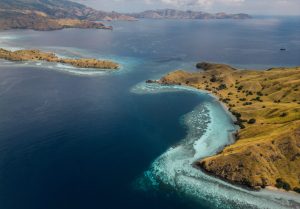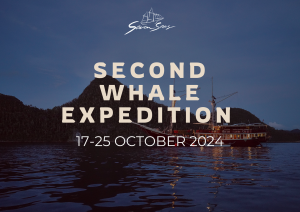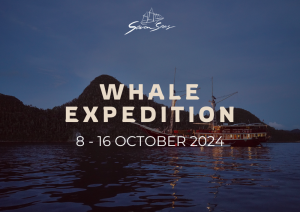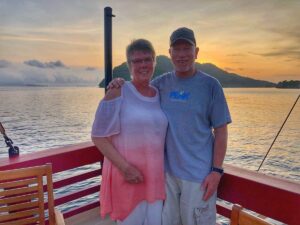By Joanna Simpson.
Raja Ampat – a `sea life experience` on the Seven Seas
Our stay on the Seven Seas Liveaboard was not a diving trip, nor was it a pleasure cruise: it was a `sea life experience`. We learned to experience living at sea, and we were privileged to study and enjoy the lives of all the creatures that call the sea their natural home.
Our group of 10 people, loosely connected through mutual acquaintance, ranged in age from 34 to 71 years, and, for all of us, the visit to the archipelago islands and seas of Raja Ampat was to be our first, and possibly only, opportunity to taste the rich and unique bio-diversity of this area of growing tourism interest.
The Seven Seas herself is, quite simply, a beautiful ship. She boasts some of the most elegant and captivating lines of all the comparable ships we saw sailing to and from Sorong, our Papua departure point. Her living areas, cabins and decks are all spacious and well-considered, providing every personal comfort required of holiday accommodation, and the available equipment allows guests to indulge in a diverse range of water-based activities (in addition to diving). She is basically a compact, self-contained floating lodge – a boutique lodge of classic design and unostentatious breeding. And the crew (outnumbering us by 7 people!) are the backbone of this sea world, knowledgeable, helpful, always smiling and always available.
Our itinerary was set, but flexible. And here I must pay tribute to the professional 3-way communication between Karl, Captain Wahyu, and the overseas owner of the Seven Seas. Their constant updating and monitoring of the weather conditions, and our consequent mid-trip redirection further south than originally envisaged, ensured us a fine and seamless sailing experience. We only had one day of rain during the 12-day period of forecasted storms and heavy swells – we were prepared for the worst and blessed with the best.
Our final route took us from Sorong to the northern islands of Raja Ampat, where we zigzagged around the southern bays and points of Waigeo Island, and then south for a second week of discovery around Misool Island. We covered the long hauls at night and spent every day motoring among and exploring ever more extraordinary and remote locations.
The main focus of our 12-day trip was snorkelling (at least one, and often two, sessions per day). And the two main attractions of these daily adventures, vying constantly for top billing, were the corals and the fish.
For me personally, it was the corals that won my heart and captivated my imagination: their unimaginable variety and richness blew away all my previous preconceptions. Yes, we saw the cliché-ruined `garden-like` stretches of sea-bed, but we also saw Gaudi-esque architectural townscapes, boasting increasingly exquisite shapes and spans, stacked up layer-upon-layer and interlocked like congested inner-city suburbs. We peered down on vast table-top structures straddling brain-coral and fern-like fronds, then burgeoning statuesque flower-like creations growing ever fuller and more majestic as they dropped away into the murky depths of sheer subterranean rock escarpments.
And for as far as you can see the coral, there are fish, bigger and more sinister as they loom from the darker depths, but always there.
The fish……. They are by no means second-best – I was probably just better prepared and programmed to meet them rather than their stationary co-dependents. It is impossible to enumerate all the different species and individuals (although the Seven Seas library and her crew are always on hand to help with identification); every one of them is unique, and no TV programme can ever prepare you for the magical colour and movement in these coral seas. One moment you are captivated by the wiggling movements of a clownfish in his anemone, then you are speechless in the midst of a gracefully passing shoal of fusiliers.
And all the time, all around you, it is `busy`. There are fish of all shapes, sizes and colours constantly picking, nibbling and biting at coral. There are moray eels gasping and `jawing` in the doors of their eerie daytime hideouts; there are tiny fluorescent-blue damselfish catching and reflecting every shaft of light that makes it through the water`s surface; there are blousy multicoloured parrotfish cruising in and around their coral apartments; and, every now and then, an inquisitive delicate batfish will look you in the eye, assess you, and move on with his daily business.
All of these magical creatures are fascinating and addictive to watch, but for sheer grace and breathtaking majesty, there can only be one outright winner – the manta rays. What a priviledge to witness some of these magnificent creatures `going about their regular chores`! As I said, ours was a snorkelling group, we were not diving down to the sea floor, so our chance to watch and share time with the rays was from the surface of the water.
On our fifth morning we arrived at Arborek Island, anchoring near several other liveaboards of various sizes and nationalities. Before we ventured offshore to see the mantas, we did actually enjoy some of our most exuberant fish-viewing of the trip; we swam around and under the jetty, and here we saw probably the largest aggregation of fish species of the trip. The sheer numbers and colours were unbelievable.
We were even allowed to feed the fish with some scraps, and the frenzy that engulfed us verged on the scary. We were swamped and overwhelmed, and it was almost a `pinch-me-to-prove-this-is-real` experience! So that was our first `high` of the day. We then motored further away from the shore in the tenders, out into the open sea. Here we began our snorkelling above the `cleaning stations` (the specific areas where the manta rays come to be `cleaned` by smaller fish). The swell was quite strong, the water a little murky, and my mask needed constant readjusting, and it looked like this would not be a `cleaning` day – this was not stacking up to be my favourite experience.
Then the mantas appeared. They were huge. And their ghostly flying through the cloudy depths below us was almost surreal. I bobbed and dipped on the surface of the water and forgot all my discomfort as I gazed at these unbelievably elegant giants. I can understand the magic of diving to the sea floor and sitting in amongst these creatures, but I am more than fulfilled after watching them through the soft-focus of a more distant perspective. I will probably never again see a manta ray its own natural world, but I will have the memory of my `moment`.
So much for sublime contemplation. Further south, around the shores of Misool Island, Karl presented us with melodramatic sensation – we swam with sharks! We unloaded from the tender onto a white sandy beach where there was a pontoon-of-sorts, two men sweeping, a patrol boat and a lot of hermit-crabs. We tiptoed into the crystal clear water, in the lee of the curving coconut palms……… followed by some of the boys carrying bloody meat scraps.
As soon as the blood began dripping into the water, the sharks were there. They shot past and around us with jaws snapping and tails flicking in every direction. As more blood and meat hit the water, their numbers increased and we were standing right in the middle of a feeding frenzy.
Some of us snorkelled and the others just looked down through the water`s surface into the tangle of cruising killers! The sharks were black-tipped youngsters, but the profile of a baby shark and a full-grown adult is exactly the same, and when we put our heads into the water and scanned around, there was little to tell our brains that these babies were harmless! I kept my fingers curled into my palms……
Yes it was sensationalism, but it was incredibly good fun. Bigger is not necessarily better, but it is definitely more attention-grabbing. And so, on and off throughout the trip, we all felt honoured and uplifted when the occasional turtle joined us during a lazy snorkel; and the glimpse of a distant school of dolphins off the ship`s bow never failed to bring us all up onto the deck with heart-melting gasps.
But our land-based adventures were equally exciting and novel. In between the snorkelling sessions, there were many opportunities to explore inland jewels in the Raja Ampat crowns. Our first day took us on to shore at the Port of Waisai, and here we got in amongst the local fish markets, souvenir stalls, chickens and, sadly, plastic rubbish. We then travelled through jungle-flanked gravel roads to view a new fish-farm and an adjoining soon-to-be-opened holiday resort. This is one Papuan world – intriguing for so many reasons, not least being the aspirations of a poor nation to embrace tourism, but unspectacular. Spectacular came when we went deeper into less-populated territory.
The Red Bird of Paradise walk. We were prepared to see one bird, that was bait enough. Leaving at 4.00am on our third day, the tenders took us away from the Seven Seas for a transfer to local dugout canoes (these were the only way to cross the sandbars at low tide) and a torch-lit paddle upriver into looming jungle. This was our very own journey into the heart of darkness…… It was early, eerie and exhilarating.
We arrived at some rough-hewn steps attached to a wooden jetty, and from there we picked our way up a muddy steeply-rising track (with on-and-off handrail), using the gnarly roots as footholds and weaving our way around skinny saplings and dripping branches. The light was starting to come through the canopy and the early dawn chorus began to sound. Then, as the silhouettes of trees reaching far above began to define themselves, we heard a seemingly artificial note – a strange attempt at birdsong. It was our local guide Simon, falling back from our group, holding his nose and emitting this unreal (but spot-on accurate) sound.
Suddenly, he was answered. It was another `moment` – a bird was replying to his call. Shortly afterwards, as the sky brightened, we crested the hill beneath the tallest tree in the jungle, and there was Simon`s new friend, high up in the very top of the canopy. He was magnificent, displaying his heart out – and the girls loved him! And while we watched, seated on makeshift but very adequate wooden benches, our bird was joined by another male and four females, all revved up in a displaying/mating frenzy. The shivering somersaulting males spread their wings and tipped upside-down, allowing their tail-wire feathers to drop and frame their vivid red and yellow bodies .
It was mesmerising, and so beautiful – and all the time Simon continued to call and be answered. We tried to take pictures, but it was better to just sit and gaze upwards, taking in the ritual manoeuvring of this dawn performance.
We left after an hour and made our way downhill again, taking a side-trip in the jungle to the house of great Victorian naturalist Alfred Russell Wallace. This was possibly replica, but the story of his part in the theory of evolution is historically fascinating and was brought to life by immersing ourselves in Wallace`s isolated real-world location.
There were a few more opportunities for land excursions after leaving the northern islands of Raja Ampat although the archipelago to the east of Misool Island is not made for trampers and campers!
We arrived after 14 hours of motoring from the north. The crew `swung` the boat around on its axis within the lee of several limestone atolls rising out of the sea like floating Mayan ruins, and secured us in place with stretched stays/ropes and the anchors. This was kayaking country, and we launched ourselves off the pontoon as soon as we were in place. Birds were everywhere, parakeets screeching from the rocky outcrops and frigate-birds soaring above us on the thermals.
Here the Jurassic outcrops are scored with dark striations from the extreme weather, and covered with rainforest plants desperately clinging to the perpendicular walls. Orchids are also an unlikely attraction, dotted across the rock faces amongst the less vivid undergrowth. The place feels ancient. And looking back from our kayaks (as we dodged the huge schools of sprats jumping around us), the Seven Seas had never looked so proud – she owned the setting, standing tall and still in the wind-rippled sea.
Our shore landing that morning was not far from our anchorage, the first chance to stand on dry land for a couple of days. We beached on a short stretch of stony shoreline and scrambled up through prickly undergrowth and sharp granite rocks, dodging the ants and walking over the hermit-crab trails. It was slippery and treacherous, but only a short distance, and at the crest of the rocky shoulder, we hit pay dirt – the view! A vast stretch of flat ocean, fronted by our lush green world of Pandanus trees and grasses and finishing with a distant horizon of hazy shoreline and a myriad more atoll islands.
It was a brief and fun encounter with the land, and a great backdrop for selfies and seascape photos – also an apparently well-known spot for the crew to access wifi service!
The next day was a much more serious and longer walk, following in the footsteps of the President`s recent visit. We motored past needles of rock, small tree`d islands, distant shoreline villages and a handful of liveaboards, ending up in a deserted lagoon. Deserted except for a remarkably smart-looking jetty (unlike the usual crumbling bamboo and earth `steps` that we had come to expect for the embryonic tourist trade). The place was immaculate, and as we made our way up the cliff-clinging boardwalk track to the summit, we could see all the old discarded steps and handrails thrown down below us.
And the viewing area at the top did not disappoint either – formal tables and seats and modern rubbish-bins. The views were not modern though, rather scenes frozen in time. The President had been shown the very best of course, endless forest-drenched islands and crystal-clear lagoons jostling for space and disappearing into the distant horizon. It was a place for peace and reflection, carved out by nature and time, and seemingly untouched by man.
From here onwards our land trips took a different turn, they were all about land below ground – caves.
Our first expedition followed on directly from the `President`s Lookout` walk. The boat-ride was a real adventure (and that`s not just because of the drivers` use of their favourite two speeds – fast and very fast). We started by cruising into a sheltered bay with low-slung rock overhangs – under these were funerary remains, skulls and bones; then it was up to a frieze of rock paintings (red drawings of bony fish and eel-like sea creatures); then an exhilarating dash through acres of open-water pearl-farm beds (watched by hidden sentries, no doubt armed, in precarious watch-towers): and finally into another group of secluded bays.
At our first site, we stayed in the boat and floated through a tunnel of hanging stalactites and weird rock formations – it was dark and unearthly, but we could still see the light and the clear turquoise water at either end. Somewhat acclimatised, we were then ready for the `swimming cave`.
The cathedral-like entrance of this next treat was partially hidden behind hanging roots and overgrown rainforest, and we disembarked onto a rough broken pontoon and stepped gingerly towards the interior beach and landing spot. It was light and warm here, but the water turned into a dark and sinister river disappearing into the bowels of the earth.
The atmosphere here was less friendly; the bottomless and silent underworld was unnerving. But four fearless members of our group `took the plunge` and swam away into the darkness, returning some 40 minutes later having reached the other side and enjoyed the challenge. The rest of us splashed in the sunlit waters, moving between warm and cold patches, following fish around the rocks, and generally enjoying bonding in timidity!
This was an activity-packed day. On the way back to the Seven Seas, Karl arranged one more side-trip – a jungle-bash through the undergrowth to a jellyfish lake. A local `caretaker` allowed us onto the track, and we found the grey lake teeming with hundreds of assorted jellyfish. Launching themselves off the predictably unstable bamboo platform, two hardy souls swam in among the creatures – a very special experience, but not for the faint-hearted. Our top-speed motor back to the Seven Seas, silhouetted against the setting sun, capped off an exhausting day. Cocktails and our usual gourmet dinner on deck were never so welcome……….
But there was one more cave to be seen, at the end of our second-last day at sea, before our return trip to civilisation. The weather was closing in after our shark-feeding episode, so Captain Wayhu moved us to a new area and Karl guided us in the tender to the `bat cave`. It was so unexpected. The virtually-hidden entrance was beyond tangled branches, an unmarked earthen path and another rickety bamboo ladder. The dry cavern opened up before us; there were shells and old bones littering the floor (probably fishermen`s leftovers), and we caught our first glimpse of the massive flying buttresses and carved columns reaching from floor to ceiling .
This was one of my favourite sites – the natural architecture was straight from a medieval cathedral. With torches on, we trod carefully over the packed-down guano floor and then twisted and crawled our way around a circular route previously mapped out by Karl. And everywhere there were acres of roosting bats in the crevices and hollows above our heads. It was a magical end to another extraordinary day.
But every day of our trip was extraordinary for us. In between snorkelling, swimming, kayaking and exploring the heights and depths of coral atolls, we walked around a couple of local villages and the crew organised several fishing-trips and musical entertainment, but it is the unquestionably world-class undersea world and island wilderness areas of Raja Ampat that will remain as a special memory for all of us. We were privileged to share this precious environment of bio-diversity in person, and we will forever commit to help preserving its unique heritage status.
Joanna Simpson
February 2018
NOTE :
To reserve your spots or see available trips, please check out our schedule page :
Schedule & Availability
Please also don’t hesitate to reach out to us at [email protected] should you require any further information or need recommendations for accommodation or flights etc. Our reservation team would be more than happy to assist. Cheers!
Follow us on instagram or Contact Us for more information about Raja Ampat – a `sea life experience` on the Seven Seas.





